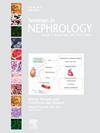阿根廷的特殊情况:解决未经诊断的透析患者所面临的挑战。
IF 3.5
3区 医学
Q2 UROLOGY & NEPHROLOGY
引用次数: 0
摘要
在阿根廷,需要接受透析治疗的第三个主要亚群是原因不明的肾衰竭患者,也称为不明原因的慢性肾脏疾病(CKDUO)。在这项回顾性队列研究中,使用国家透析和移植登记处的数据描述了该组的特征。在阿根廷,从2004年4月1日至2021年12月31日(213个月),113352名患者开始了维持性透析;42%的患者年龄大于65岁,2.3%的患者年龄小于18岁。男性患者占多数(66,650例[58.8%]),外籍患者占6%(6,688例)。只有9.4%的患者(10655人)通过肾活检确诊。需要入院透析的肾脏疾病最常见的原因是糖尿病肾病(36%)、高血压肾病(21%)和CKDUO(17%)。最常见的透析方式是血液透析,大多数入院时有临时血管通路。开始透析后的平均生存时间为44.8个月,CKDUO患者为59.2个月(95%可信区间,58.0-60.4),其他患者为48.6个月(95%可信区间,48.2-49.0)。CKDUO患者较年轻,多为女性,合并症较少,社会经济地位更不稳定,并且有肾脏健康援助迟或缺乏的指标。不同州的肾活检率与诊断工具的可及性有关。需要制定卫生政策和卫生行动,以便在慢性肾病的早期阶段获得肾脏健康。本文章由计算机程序翻译,如有差异,请以英文原文为准。
Special Situations in Argentina: Addressing the Challenges Faced by Individuals on Dialysis Without a Diagnosis
The third major subgroup requiring admission to dialysis in Argentina are individuals with kidney failure without a known cause, also known as chronic kidney disease of unknown origin (CKDUO). In this retrospective cohort study, the characteristics of this group were described using data from the National Dialysis and Transplant Registry. In Argentina, 113,352 patients commenced maintenance dialysis from April 1, 2004, to December 31, 2021 (213 months); 42% of patients were older than 65 years of age and 2.3% were younger than 18 years of age. There was a predominance of male patients (66,650 [58.8%]) and 6% were foreigners (6,688). Only 9.4% of patients (10,655) had a diagnosis confirmed by a kidney biopsy. The most common causes of kidney disease requiring dialysis admission were diabetic nephropathy (36%), hypertensive nephropathy (21%), and CKDUO (17%). The most frequent dialysis modality was hemodialysis and the majority were admitted with temporary vascular access. Mean survival time from the initiation of dialysis was 44.8 months, with 59.2 months (95% confidence interval, 58.0-60.4) for patients with CKDUO versus 48.6 months (95% confidence interval, 48.2-49.0) for others. Patients with CKDUO were younger and more frequently female, with fewer comorbidities, more precarious socioeconomic status, and indicators of late or absent renal health assistance. There was a heterogeneous renal biopsy rate by state related to the accessibility of diagnostic tools. Health policy and health actions are required to allow kidney health accessibility in earlier stages of chronic kidney disease.
求助全文
通过发布文献求助,成功后即可免费获取论文全文。
去求助
来源期刊

Seminars in nephrology
医学-泌尿学与肾脏学
CiteScore
5.60
自引率
0.00%
发文量
27
审稿时长
6-12 weeks
期刊介绍:
Seminars in Nephrology is a timely source for the publication of new concepts and research findings relevant to the clinical practice of nephrology. Each issue is an organized compendium of practical information that serves as a lasting reference for nephrologists, internists and physicians in training.
 求助内容:
求助内容: 应助结果提醒方式:
应助结果提醒方式:


